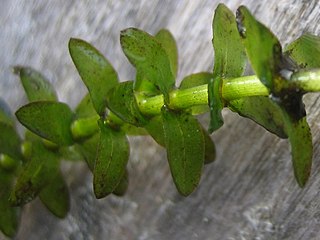
Elodea is a genus of 6 species of aquatic plants often called the waterweeds described as a genus in 1803. Classified in the frog's-bit family (Hydrocharitaceae), Elodea is native to the Americas and is also widely used as aquarium vegetation and laboratory demonstrations of cellular activities. It lives in fresh water. An older name for this genus is Anacharis, which serves as a common name in North America.

Stratiotes is a genus of submerged aquatic plant commonly known as water soldiers, described as a genus by Linnaeus in 1753. Several specific names have been coined within the genus, but at present only one is recognized: Stratiotes aloides. native to Europe and NW Asia.

Myriophyllum aquaticum is a flowering plant, a vascular dicot, commonly called parrot's-feather and parrot feather watermilfoil.

Alisma gramineum is a small aquatic plant in the water-plantain family. It has several common names including narrowleaf water-plantain, ribbonleaf water-plantain or ribbon-leaved water-plantain, and grass-leaved water-plantain. It grows in mud or submerged in shallow fresh or brackish water in marshy areas.

Alisma lanceolatum is a species of aquatic plant in the water plantain family known by the common names lanceleaf water plantain and narrow-leaved water plantain. It is widespread across Europe, North Africa and temperate Asia. It is naturalized in Australia, New Zealand, Oregon, California and British Columbia. It is considered a noxious weed in some places.

Sagittaria longiloba is a North American species of flowering plant in the water plantain family known by the common name longbarb arrowhead and Gregg arrowhead.

Sparganium angustifolium is a species of flowering plant in the cat-tail family known by the common names floating bur-reed and narrowleaf bur-reed. It has a circumboreal distribution, occurring throughout the northern latitudes of the Northern Hemisphere. It is an aquatic plant, growing in water up to 2.5 meters deep. Its habitat includes acidic, low-nutrient freshwater bodies such as ponds, lakes, slow-moving streams, and ditches. It can become abundant, practically covering the surface of the water. It is a perennial herb producing a floating stem with long, narrow, flattened leaves which can be quite long, sometimes reaching over two meters. It is monoecious, individual plants bearing both male and female inflorescences. These are spherical, the male inflorescence a ball of stamens and the female inflorescence a ball of developing fruits.
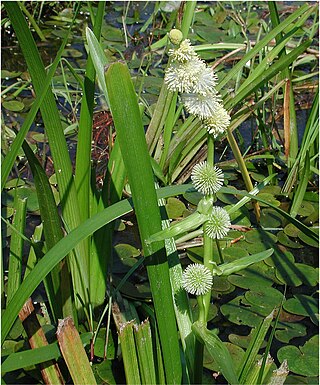
Sparganium emersum is a species of flowering plant in the cat-tail family known by the common names European bur-reed and unbranched bur-reed. It has a circumboreal distribution, occurring throughout the northern latitudes of Eurasia and North America. It is an aquatic plant, growing in shallow water bodies such as ponds and streams. It can become abundant at times. It is a perennial herb producing a floating stem up to 2 meters long. The leaves may be limp and floating or stiff and erect, emerging above the water surface. The leaves are flat and straplike, sometimes with a triangular, keeled base that can help distinguish it from the similar Sparganium angustifolium. It is monoecious, individual plants bearing both male and female inflorescences. These are spherical, the male inflorescence a ball of stamens and the female inflorescence a ball of developing fruits growing beneath the male spheres.

Limnocharis flava is a species of aquatic flowering plant which is native to Mexico, Central America, South America, Cuba, Haiti and the Dominican Republic but widely naturalized in southern and southeastern Asia: India, Sri Lanka, Cambodia, Burma, Thailand, Vietnam, Indonesia, Malaysia, Brunei and southern China.

Najas gracillima, the slender waternymph, is a submerged species of aquatic plant in the Hydrocharitaceae family. found in lakes and streams. It is native to China, Russian Far East, Japan, Korea, Taiwan, Iran, Alberta, Ontario, Newfoundland, Nova Scotia, New Brunswick, the eastern United States. It is also considered introduced and naturalized in France, Spain, Italy and California.

Sagittaria isoetiformis, common name quillwort arrowhead, is an aquatic plant species. It is similar to Sagittaria tenuis and often mistaken for it, but S. isoetiformis has flattened leaves rather than leaves round in cross-section. Leaves of both species are usually submerged but sometimes emerging from the water.
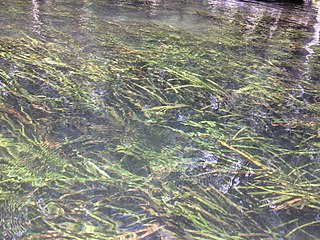
Sagittaria kurziana, common names springtape and strap-leaf sagittaria, is a perennial aquatic plant. It grows up to 250 centimetres tall. It has long, narrow, flat leaves that float on the surface of the water, up to 250 cm long but rarely more than 15 millimetres wide. These form huge masses of ribbon-like leaves flowing back and forth with the current. Inflorescences also float on the surface, the white flowers very often submerged.

Sagittaria teres, the quill-leaved arrowhead or slender arrowhead, is an aquatic plant species in the genus Sagittaria. It is a perennial herb up to 80 centimetres tall. The leaves can grow both under and above the water. The flowers are white, up to 1.5 cm in diameter, borne in one or more whorls on a stalk rising above the leaves.

Sagittaria brevirostra, common name Midwestern arrowhead or shortbeak arrowhead, is an aquatic plant species native to North America. It is a perennial herb growing up to 70 centimetres tall, with arrow-shaped leaves and white flowers.

Sagittaria filiformis, the threadleaf arrowhead, is a perennial aquatic plant growing up to 170 centimetres tall. Some leaves are thread-like, entirely underwater, but others are narrowly ovate or lanceolate and floating on the surface.

Sagittaria engelmanniana is a perennial aquatic plant growing up to 70 centimetres tall. The leaves are sagittate (arrow-shaped) with 3 very narrow lobes.

Sagittaria graminea, the grassy arrowhead or grass-leaved arrowhead, is an aquatic plant species native to eastern North America.

Sagittaria subulata, the awl-leaf arrowhead, narrow-leaved arrowhead or dwarf sagittaria, is an aquatic plant species.
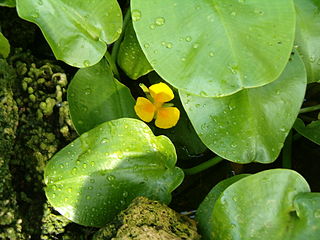
Hydrocleys is a genus of aquatic plants in the Alismataceae, native to the Western Hemisphere, though one is naturalized elsewhere and sold as an ornamental for decorative ponds and artificial aquatic habitats. At present, five species are recognized:
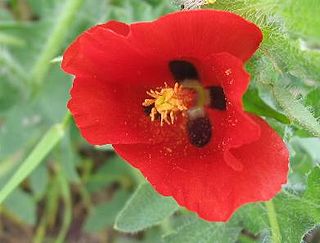
Glaucium corniculatum, the blackspot hornpoppy or red horned-poppy, is a species of the genus Glaucium in the poppy family (Papaveraceae). It is an annual flowering plant, occurring in southern Europe, and grows up to 1 foot (30 cm) high. The stem and leaves are hairy, the capsule fruit is covered with stiff hair, the flower is red, with a black spot on the base of the tepal bract, which has a yellow margin around it. The flower appears from June until August.






















